Abstract
Combustion syntheses involving intermetallic and thermitic reactions were conducted to fabricate FeAl–TiB2–Al2O3 composites. Two combustion systems consisting of Fe, Al, Ti, Fe2O3 and B2O3 were studied for formation of xFeAl–yTiB2–Al2O3 composites with x = 1.5–3.5 and y = 0.5–0.8. In the reaction series, thermitic reduction of Fe2O3 and B2O3 by Al thermally activated the reaction between Fe and Al. As a result, the combustion wave of the synthesis reaction was sufficiently exothermic to propagate in a self-sustaining manner. With an increase in TiB2 and FeAl of the composites, the decrease of reaction exothermicity resulted in a decline of the combustion wave velocity and reaction temperature. The activation energy Ea = 88.92 kJ/mol was deduced for the synergetic combustion reaction. Based on XRD analysis, a thorough phase conversion was achieved and composites composed of FeAl, TiB2, and Al2O3 with different contents were obtained. The SEM micrograph showed the FeAl-based composite with a dense and connecting morphology.
1. Introduction
Aluminides of transition metals such as titanium, iron, nickel, and niobium are recognized by their excellent physical and mechanical properties [1,2,3]. Among these compounds, iron aluminides (FeAl and Fe3Al) are of considerable interest for high-temperature structural applications, due to their inexpensive raw materials, high melting point, low density, and outstanding resistance to corrosion at elevated temperatures under oxidizing, sulfidizing, and carburizing atmospheres [1,4,5,6]. Moreover, FeAl exhibits high electrical resistivity, which renders it suitable as a heating component [7]. Porous FeAl intermetallic foams are promising in a hot and aggressive environment like the industrial chimney, where FeAl foams work as a corrosion-resistant gas filter to reduce the emission of smog-forming particles generated from coal and hydrocarbon combustion [8,9,10]. However, the main drawbacks of iron aluminides are their low ductility and brittle fracture at room temperature and poor wear resistance [4,5]. The addition of ceramic components, such as TiB2, TiN, TiC, WC, Al2O3, and ZrO2, as reinforcement has proven to effectively improve the room-temperature mechanical properties in nickel and iron aluminides, their wear resistance and high-temperature strength without degrading the inherent oxidation resistance [11,12,13,14,15].
A number of manufacturing methods have been applied to produce ceramics-iron aluminide composites, including mechanochemical synthesis [14], spark plasma sintering [15], hot pressing [16], liquid-phase sintering [17], thermal explosion [18] and self-propagating high-temperature synthesis (SHS) [19,20]. Combustion synthesis in the SHS sense is recognized by its high energy effectiveness, rapid reaction process, easy operation, diversity of products, and in situ formation of composite components [21,22,23]. When incorporated with a thermitic reaction using Al as the reducing agent, the thermite-based SHS method is an in situ production route to fabricate Al2O3-reinforced ceramics and intermetallics [24,25]. Moreover, aluminothermic reduction of metal oxides is advantageous to the SHS process in thermodynamic aspects. According to Wang et al. [24], a variety of composite materials with uniformly distributed phases have been simultaneously produced by thermite-based combustion synthesis. The materials include not only ceramic-metal composites (e.g., Al2O3-Cr and Al2O3-Fe), but also Al2O3-added borides (e.g., TiB2, VB2, MoB, and WB), carbides (e.g., TiC, SiC, B4C, Cr3C2, and WC) and silicides (e.g., MoSi2, ZrSi2, and WSi2).
By means of the classical SHS technique, aluminides of nickel, titanium, and cobalt (e.g., NiAl, Ni3Al, TiAl, and CoAl) have been produced from compacted metal powders of corresponding stoichoimetries [26,27,28]. However, formation of FeAl and Fe3Al from direct intermetallic reaction in the Fe–Al system is not feasible, owing to their low enthalpies of formation (i.e., FeAl with ΔHf = –50.2 kJ/mol and Fe3Al with ΔHf = –67 kJ/mol) [1]. In contrast, the thermitic reaction of Fe2O3 with Al is extremely exothermic (i.e., the heat of reaction ΔH = –852.3 kJ per unit mole of Al2O3 and adiabatic temperature Tad = 3622 K) [24]. Therefore, this study aims to take advantage of the thermite-based SHS method to fabricate FeAl–TiB2–Al2O3 in situ composites. The reaction systems involve the intermetallic reaction of Fe and Al, as well as aluminothermic reduction of Fe2O3 and B2O3. Composites with different contents of FeAl and TiB2 were synthesized. The activation energy of the thermite-based SHS reaction was determined from the measured reaction temperature and combustion front velocity. In addition, the constituents and fracture surface microstructures of as-synthesized composites were investigated.
2. Materials and Methods
The starting materials included Fe2O3 (Alfa Aesar Co., <45 μm, 99.5% Ward Hill, MA, USA), B2O3 (Strem Chemicals, 1–2 μm, 99.6%, Newburyport, MA, USA), Al (Showa Chemical Co., <45 μm, 99.9%, Tokyo, Japan), Fe (Alfa Aesar Co., <45 μm, 99.5%), and Ti (Alfa Aesar Co., <45 μm, 99.5%). Two oxide powders, Fe2O3 and B2O3, were employed as thermite reagents. Similar to Fe2O3, the thermitic reaction of B2O3 with Al is exothermic and has ΔH = –403.8 kJ/mol of Al2O3 and Tad = 2315 K [24], which is also advantageous to the SHS process. Moreover, instead of expensive elemental boron, B2O3 serves as the source of boron for the formation of TiB2. Two combustion systems of different stoichiometries were formulated for synthesis of FeAl–TiB2–Al2O3 composites and expressed as Reactions (1) and (2).
where the stoichiometric coefficients, x and y, denote the numbers of mole of FeAl and TiB2 formed respectively from Reactions (1) and (2) in the FeAl–TiB2–Al2O3 composites.
As can be seen, Reaction (1) is formulated by fixed amounts of Fe2O3, B2O3, and Ti to keep the quantities of TiB2 and Al2O3 constant in the products. With the increase of x, the product of Reaction (1) contains a higher content of FeAl. On the other hand, Reaction (2) has variable contents of Fe2O3 and B2O3. A larger y in Reaction (2) signifies an increase in B2O3 and Ti to yield TiB2 at a larger amount. In Reaction (2), the decrease of Fe2O3 as y increases is balanced off by extra Fe powders to keep the same number of mole of FeAl formed in the products. Test matrices investigated by the present work are 1.5 ≤ x ≤ 3.5 for Reaction (1) and 0.5 ≤ y ≤ 0.8 for Reaction (2), within which the combustion wave propagates in a stable and self-sustaining manner.
The powders of raw materials were thoroughly mixed in a ball mill and then compressed into cylindrical test specimens with a diameter of 7 mm, a length of 12 mm, and a relative density of 60%. The SHS experiments were conducted in a stainless-steel chamber equipped with viewing windows under a high-purity argon environment (99.99%). The combustion wave propagation velocity (Vf) was determined from the time series of recorded images. The reaction temperature was measured by a 125 μm R-type thermocouple (Pt/Pt-13%Rh) attached on the sample surface. Phase analyses of product constituents were performed by an X-ray diffractometer (Bruker D2, Bruker Co., Billerica, MA, USA) using CuKα radiation. The microstructure and atomic percentage of elements were examined under a scanning electron microscope (Hitachi, S3000H, Tokyo, Japan) coupled with energy dispersive spectroscopy (EDS). Details of the experimental setup and method were previously reported [29].
3. Results and Discussion
Self-Propagating Combustion Wave Kinetics
Figure 1 illustrates a typical series of the combustion images recorded from Reaction (1) with x = 3.0. It is apparent that a well-defined combustion wave develops upon ignition and traverses the entire sample in a self-sustaining manner. The synthesis reaction required no additional heat input. The combustion wave spent about t = 4.8 s to reach the end of the sample.
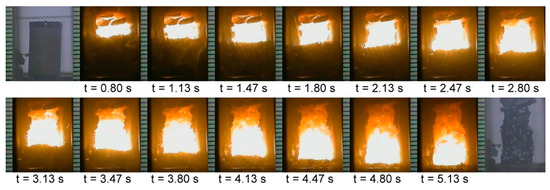
Figure 1.
A time sequence of sample images recoded from Reaction (1) with x = 3.0 illustrating self-propagating combustion wave.
It is useful to note that in Reaction (1), the increase of Fe and Al (i.e., the coefficient x) for increasing FeAl imposes a dilution effect on combustion due to the low formation enthalpy of FeAl. Experimental observations indicated a combustibility limit for Reaction (1) at x = 3.5, beyond which the reaction ceased to proceed after ignition. However, for Reaction (1) with x < 1.5, a violent and hasty reaction accompanying substantial sample melting occurred, which led to incomplete phase conversion as a result of insufficient reaction times. This explains the range of 1.5 ≤ x ≤ 3.5 for Reaction (1) in this study. For Reaction (2), since the thermitic reaction of B2O3 is less energetic than that of Fe2O3, the exothermicity of whole aluminothermic reduction declines with the increase of y and it was found that the reaction was extinct in Reaction (2) at y > 0.8.
The effect of sample stoichiometries on combustion front velocities of Reactions (1) and (2) is presented in Figure 2. The wave speed of Reaction (1) falls from 3.17 to 1.68 mm/s with increasing x from 1.5 to 3.5. The increase of x in Reaction (1) increases FeAl formed in the composite by having additional Fe and Al, but makes no change in the amount of Ti and the thermite composition. Because the increase of Fe and Al in the reactant mixture had a cooling effect, the combustion wave of Reaction (1) slowed down as FeAl augmented. Figure 2 also reveals a decline in the flame-front velocity from 2.84 to 1.83 mm/s for Reaction (2) as y augments from 0.5 to 0.8. The increase of y in Reaction (2) is to increase TiB2 but maintains constant mole numbers of FeAl and Al2O3. Therefore, the decrease of overall reaction exothermicity of Reaction (2) with increasing y could be responsible for deceleration of the combustion wave.
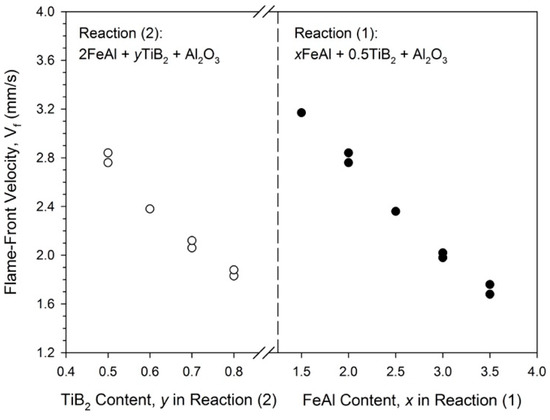
Figure 2.
Variations of flame-front velocities of Reactions (1) and (2) with stoichiometric coefficients x and y.
Figure 3 depicts typical combustion temperature profiles of Reactions (1) and (2). The profiles are characterized by an abrupt rise (i.e., a high temperature gradient), signifying rapid arrival of the combustion front, a peak value representing the combustion front temperature (Tc), and a significant descent behind the combustion wave (i.e., a rapid cooling rate). Such a unique synthesis condition leads to a uniform microstructure and phase distribution for the products [23]. Profiles #1, #2, and #3 in Figure 3 are recorded from Reaction (1) with x = 1.5, 2.0, and 3.0, respectively. The peak temperature decreases from 1318 oC for x = 1.5 to 1269 oC for x = 2.0 and 1162 oC for x = 3.0, which confirms the decrease of reaction exothermicity with increasing FeAl. Moreover, a comparison between profiles #2 (Tc = 1269 oC at y = 0.5) and #4 (Tc = 1141 °C at y = 0.8) substantiates a decline of reaction exothermicity for Reaction (2) as the content of TiB2 augments. It is useful to note that the composition dependence of flame-front velocities of Reactions (1) and (2) is consistent with that of the reaction temperature.

Figure 3.
Variations of combustion temperatures of Reactions (1) and (2) with different contents of FeAl and TiB2.
The combustion front propagation velocity and reaction temperature are essential for the kinetics analysis of the combustion wave and determination of the apparent activation energy (Ea) of a solid-state combustion reaction. The dependence of the combustion wave velocity on reaction temperature plotted in Figure 4 correlates the relationship between ln(Vf/Tc)2 and 1/Tc [30]. Based upon the slope of a best-fitted linear line, Ea = 88.92 kJ/mol was obtained for the synergetic combustion reaction. It is useful to note that the Fe2O3–Al thermitic reaction has Ea in a range between 82.3 and 97.0 kJ/mol [31]. This implies that once the kinetic barrier of reduction of Fe2O3 by Al is overcome, the synthesis sequences of Reactions (1) and (2) are able to proceed.
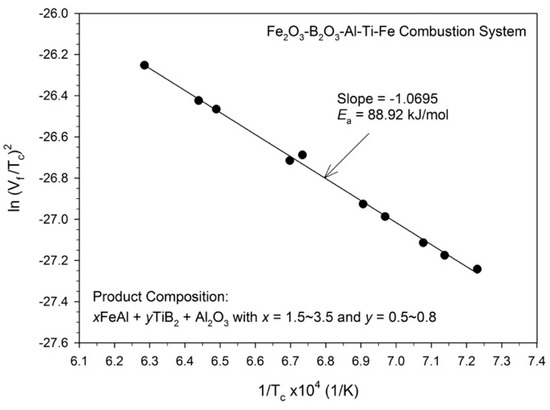
Figure 4.
Correlation of reaction temperature (Tc) and combustion wave velocity (Vf) for determination of activation energy (Ea).
Figure 5 depicts the XRD patterns of as-synthesized xFeAl–yTiB2–Al2O3 composites of different compositions. Apparently, the constituents comprise no other than FeAl, TiB2, and Al2O3, indicative of a complete phase conversion from the reactants to final products. The XRD spectra of Figure 5a,b are correspondingly associated with Reaction (1), with x = 2.0 and 3.0. The increase of FeAl is confirmed by FeAl signatures with stronger peak intensity in Figure 5b than Figure 5a. Figure 5c represents the composite with a content of TiB2 at y = 0.8 obtained from Reaction (2). It is evident that the signature peaks of TiB2 are obviously intensified in Figure 5c when compared to those in Figure 5a,b, both of which have a TiB2 content of y = 0.5.
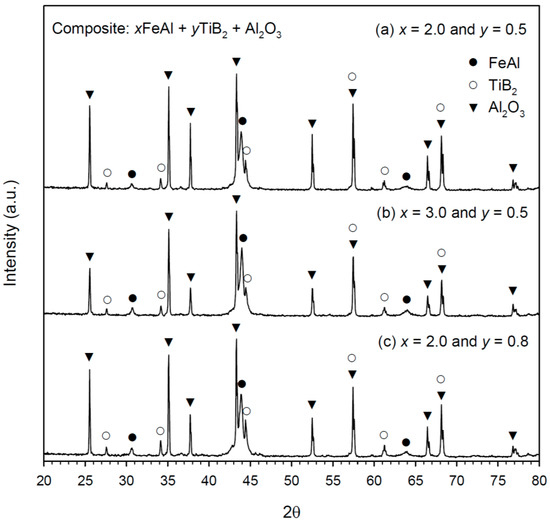
Figure 5.
XRD patterns of self-propagating high-temperature synthesis (SHS)-derived products with (a) x = 2.0 and y = 0.5, (b) x = 3.0 and y = 0.5, and (c) x = 2.0 and y = 0.8.
Figure 6 exhibits the microstructure of the fracture surface of the xFeAl–yTiB2–Al2O3 composite with x = 3.0 and y = 0.5. The morphology of the product is dense and connecting. Most of the TiB2 and Al2O3 grains are embedded in the FeAl-based agglomerates, which have a size about 20–30 μm. The EDS spectrum S1 specifies an atomic proportion of Al:O = 38:62, which certainly signifies Al2O3. The average size of Al2O3 grains is about 5–10 μm and some Al2O3 crystals are randomly distributed over the fracture surface. The spectrum S2 detects four elements Fe, Al, Ti, and B. The atomic ratio of Fe:Al is equal to 51:49, which matches well with FeAl. Based upon the elemental proportion of Ti:B = 34:66, the other component is identified as TiB2 which has a short-rod shape around 3 μm.
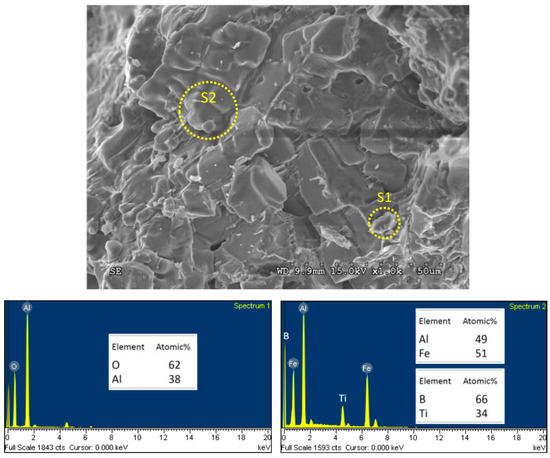
Figure 6.
SEM micrograph and EDS spectra of xFeAl–yTiB2–Al2O3 composite produced from Reaction (1) with x = 3.0 and y = 0.5.
4. Conclusions
Combustion syntheses involving intermetallic reaction of Fe with Al and thermitic reduction of Fe2O3 and B2O3 were conducted to produce FeAl–TiB2–Al2O3 composites with a broad composition. Two combustion systems, consisting of Fe, Al, Ti, Fe2O3 and B2O3 at different stoichiometries, were studied for the synthesis of xFeAl–yTiB2–Al2O3 composites with x = 1.5–3.5 and y = 0.5–0.8. For the samples formulated within the test matrix, the combustion wave propagates in a self-sustaining manner. With an increase in FeAl and TiB2, the combustion wave velocity and reaction temperature decreased from 3.17 to 1.68 mm/s and 1318 °C to 1141 °C., respectively. This was attributed to the low enthalpy of formation for FeAl and a decrease in heat release of thermitic reactions. Based on a correlation between combustion front velocity and reaction temperature, the activation energy Ea = 88.92 kJ/mol was deduced for the combined metallic and thermitic reaction. According to the XRD analysis, a complete phase conversion was achieved, and synthesized composites were composed of FeAl, TiB2, and Al2O3. The SEM micrograph showed the FeAl-based composite with a dense and connecting morphology. Three constituents were further confirmed by the EDS element ratios.
Author Contributions
Conceptualization, C.-L.Y. and C.-Y.K.; methodology, C.-L.Y. and C.-Y.K.; software, C.-L.Y.; validation, C.-L.Y. and C.-Y.K.; formal analysis, C.-L.Y. and C.-Y.K.; investigation, C.-L.Y. and C.-Y.K.; resources, C.-L.Y.; data curation, C.-L.Y. and C.-Y.K.; writing—original draft preparation, C.-L.Y.; writing—review and editing, C.-L.Y. and C.-Y.K.; visualization, C.-L.Y.; supervision, C.-L.Y.; project administration, C.-L.Y.; funding acquisition, C.-L.Y.
Funding
This research was funded by the Ministry of Science and Technology of Taiwan under the grant of MOST 107-2221-E-035-048.
Acknowledgments
The authors are thankful for Precision Instrument Support Center of Feng Chia University in providing materials analytical facilities.
Conflicts of Interest
The authors declare no conflict of interest.
References
- Deevi, S.C.; Sikka, V.K. Nickel and iron aluminides: An overview on properties, processing, and applications. Intermetallics 1996, 4, 357–375. [Google Scholar] [CrossRef]
- Kothari, K.; Radhakrishnan, R.; Wereley, N.M. Advances in gamma titanium aluminides and their manufacturing techniques. Prog. Aerosp. Sci. 2012, 55, 1–16. [Google Scholar] [CrossRef]
- Hanada, S. Niobium aluminides. Curr. Opin. Solid State Mater. Sci. 1997, 2, 279–283. [Google Scholar] [CrossRef]
- Stoloff, N.S. Iron aluminides: Present status and future prospects. Mater. Sci. Eng. A 1998, 258, 1–14. [Google Scholar] [CrossRef]
- Joslin, D.L.; Easton, D.S.; Liu, C.T.; Babu, S.S.; David, S.A. Processing of Fe3Al and FeAl alloys by reaction synthesis. Intermetallics 1995, 3, 467–481. [Google Scholar] [CrossRef]
- Masmoudi, M.; Mhadhbi, M.; Escoda, L.; Suñol, J.J.; Khitouni, M. Microstructural evolution and corrosion behavior of nanocrystalline FeAl synthesized by mechanical alloying. J. Alloys Compd. 2016, 657, 330–335. [Google Scholar] [CrossRef]
- Sikka, V.K.; Wilkening, D.; Liebetrau, J.; Mackey, B. Melting and casting of FeAl-based cast alloy. Mater. Sci. Eng. A 1998, 258, 229–235. [Google Scholar] [CrossRef]
- Karczewski, K.; Stepniowski, W.J.; Salerno, M. Amino acids aided sintering for the formation of highly porous FeAl intermetallic alloys. Materials 2017, 10, 746. [Google Scholar] [CrossRef] [PubMed]
- Karczewski, K.; Stepniowski, W.J.; Salerno, M. Fabrication of FeAl intermetallic foams by tartaric acid-assisted self-propagating high-temperature synthesis. Materials 2018, 11, 621. [Google Scholar] [CrossRef] [PubMed]
- Dudina, D.V.; Bokhonov, B.B.; Legan, M.A.; Novoselov, A.N.; Skovorodin, I.N.; Bulina, N.V.; Esikov, M.A.; Mali, V.I. Analysis of the formation of FeAl with a high open porosity during electric current-assisted sintering of loosely packed Fe–Al powder mixtures. Vacuum 2017, 146, 74–78. [Google Scholar] [CrossRef]
- Shokati, A.A.; Parvin, N.; Shokati, M. Combustion synthesis of NiAl matrix composite powder reinforced by TiB2 and TiN particulates from Ni–Al–Ti–BN reaction system. J. Alloys Compd. 2014, 585, 637–643. [Google Scholar] [CrossRef]
- Yeh, C.L.; Ke, C.Y.; Chen, Y.C. In situ formation of TiB2/TiC and TiB2/TiN reinforced NiAl by self-propagating combustion synthesis. Vacuum 2018, 151, 185–188. [Google Scholar] [CrossRef]
- Amiriyan, M.; Blais, C.; Savoie, S.; Schulz, R.; Cariépy, M.; Alamdari, H. Trio-mechanical properties of HVOF deposited Fe3Al coatings reinforced with TiB2 particles for wear-resistance applications. Materials 2016, 9, 117. [Google Scholar] [CrossRef] [PubMed]
- Khodaei, M.; Enayati, M.H.; Karimzadeh, F. The structure and mechanical properties of Fe3Al–30 vol.% Al2O3 nanoparticles. J. Alloys Compd. 2009, 488, 134–137. [Google Scholar] [CrossRef]
- Karimi, H.; Hadi, M.; Ebrahimzadeh, I.; Farhang, M.R.; Sadeghi, M. High-temperature oxidation behavior of WC-FeAl composite fabricated by spark plasma sintering. Ceram. Int. 2018, 44, 17147–17153. [Google Scholar] [CrossRef]
- Kim, Y.-I.; An, G.S.; Lee, W.; Jang, J.M.; Park, B.-G.; Jung, Y.-G.; Choi, S.-C.; Ko, S.-H. In-situ fabrication of TiC–Fe3Al cermet. Ceram. Int. 2017, 43, 5907–5913. [Google Scholar] [CrossRef]
- Schneibel, J.H.; Carmichael, C.A.; Specht, E.D.; Subramanian, R. Liquid-phase sintered iron aluminide-ceramic composites. Intermetallics 1997, 5, 61–67. [Google Scholar] [CrossRef]
- Liu, Y.; Cai, X.; Sun, Z.; Jiao, X.; Akhtar, F.; Wang, J.; Feng, P. A novel fabrication strategy for highly porous FeAl/Al2O3 composite by thermal explosion in vacuum. Vacuum 2018, 149, 225–230. [Google Scholar] [CrossRef]
- Sharifitabar, M.; Vahdati Khaki, J.; Haddad Sabzevar, M. Formation mechanism of TiC–Al2O3–Fe3Al composites during self-propagating high-temperature synthesis of TiO2–Al–C–Fe system. Ceram. Int. 2016, 42, 12361–12370. [Google Scholar] [CrossRef]
- Yeh, C.L.; Ke, C.Y. In situ formation of TiB2/Al2O3 reinforced Fe3Al by combustion synthesis with thermite reduction. Metals 2018, 8, 288. [Google Scholar] [CrossRef]
- Merzhanov, A.G. Combustion processes that synthesize materials. J. Mater. Process. Technol. 1996, 56, 222–241. [Google Scholar] [CrossRef]
- Liu, G.; Li, J.; Chen, K. Combustion synthesis of refractory and hard materials: A review. Int. J. Refract. Met. Hard Mater. 2013, 39, 90–102. [Google Scholar] [CrossRef]
- Levashov, E.A.; Mukasyan, A.S.; Rogachev, A.S.; Shtansky, D.V. Self-propagating high-temperature synthesis of advanced materials and coatings. Int. Mater. Rev. 2017, 62, 203–239. [Google Scholar] [CrossRef]
- Wang, L.L.; Munir, Z.A.; Maximov, Y.M. Thermite reactions: Their utilization in the synthesis and processing of materials. J. Mater. Sci. 1993, 28, 3693–3708. [Google Scholar] [CrossRef]
- Yeh, C.L.; Yang, W.J. Formation of MAX solid solutions (Ti,V)2AlC and (Cr,V)2AlC with Al2O3 addition by SHS involving aluminothermic reduction. Ceram. Int. 2013, 39, 7537–7544. [Google Scholar] [CrossRef]
- Yeh, C.L.; Su, S.H.; Chang, H.Y. Effects of TiC addition on combustion synthesis of NiAl in SHS mode. J. Alloys Compd. 2005, 398, 85–93. [Google Scholar] [CrossRef]
- Yeh, C.L.; Su, S.H. In situ formation of TiAl-TiB2 composite by SHS. J. Alloys Compd. 2006, 407, 150–156. [Google Scholar] [CrossRef]
- Yeh, C.L.; Yeh, C.C. Preparation of CoAl intermetallic compound by combustion synthesis in self-propagating mode. J. Alloys Compd. 2005, 388, 241–249. [Google Scholar] [CrossRef]
- Yeh, C.L.; Chen, Y.L. An experimental study on self-propagating high-temperature synthesis in the Ta-B4C system. J. Alloys Compd. 2009, 478, 163–167. [Google Scholar] [CrossRef]
- Yeh, C.L.; Chen, W.H. Preparation of niobium borides NbB and NbB2 by self-propagating combustion synthesis. J. Alloys Compd. 2006, 420, 111–116. [Google Scholar] [CrossRef]
- Rafiei, M.; Enayati, M.H.; Karimzadeh, F. Kinetic analysis of thermite reaction in Al–Ti–Fe2O3 system to produce (Fe,Ti)3Al–Al2O3 nanocomposite. Powder Technol. 2014, 253, 553–560. [Google Scholar] [CrossRef]
© 2019 by the authors. Licensee MDPI, Basel, Switzerland. This article is an open access article distributed under the terms and conditions of the Creative Commons Attribution (CC BY) license (http://creativecommons.org/licenses/by/4.0/).